
Contact us
Our team would love to hear from you.

This article describes the value and benefits of games and gamification elements, their application in different industries, trends, and a successful use case example.
To grasp the full extent of the impact games have on modern lives, consider the following impressive statistics from the Entertainment Software Association.
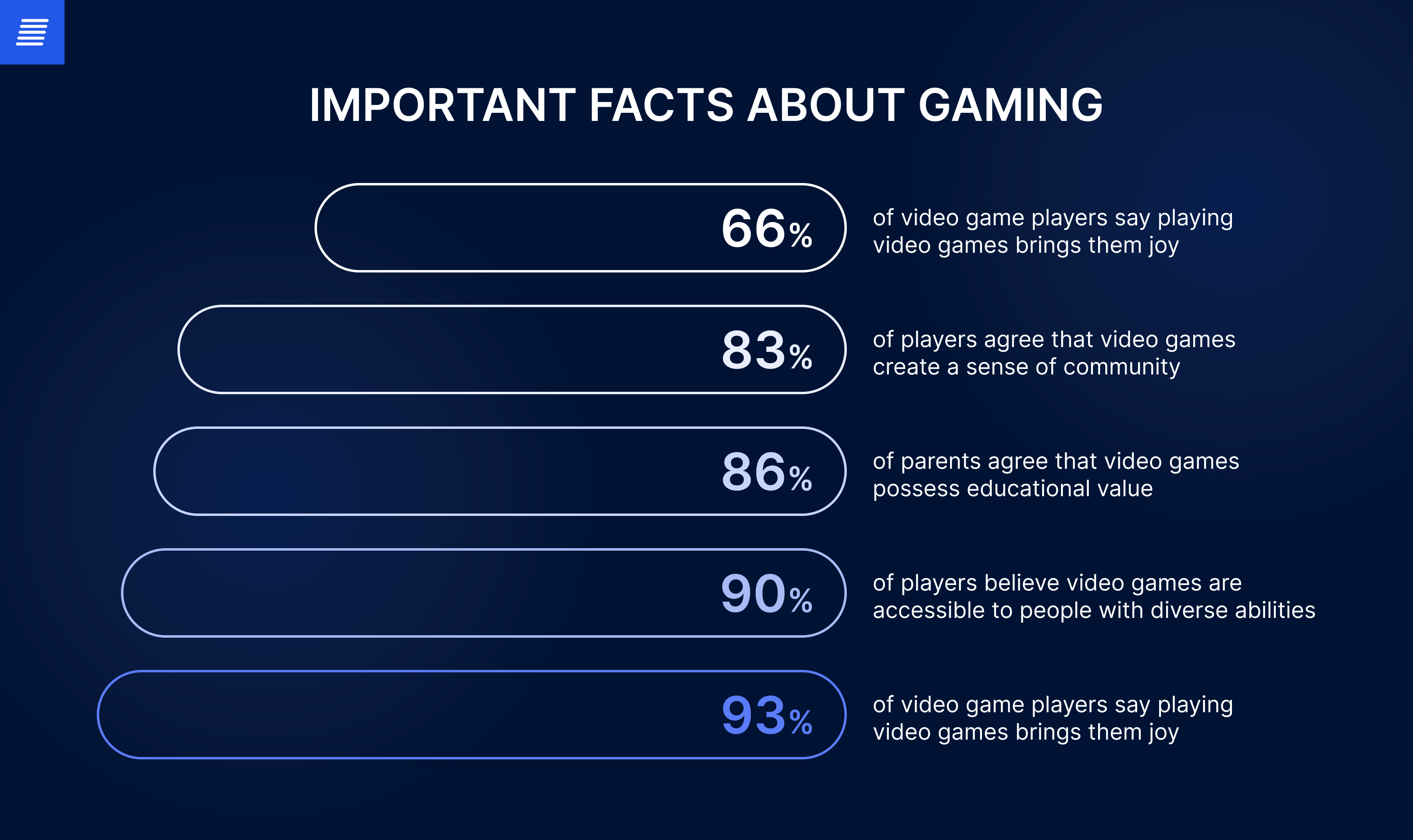
Video games are played by millions of people around the world every day. While entertainment is considered the key feature of gaming, it also helps players build skills and connect with others.
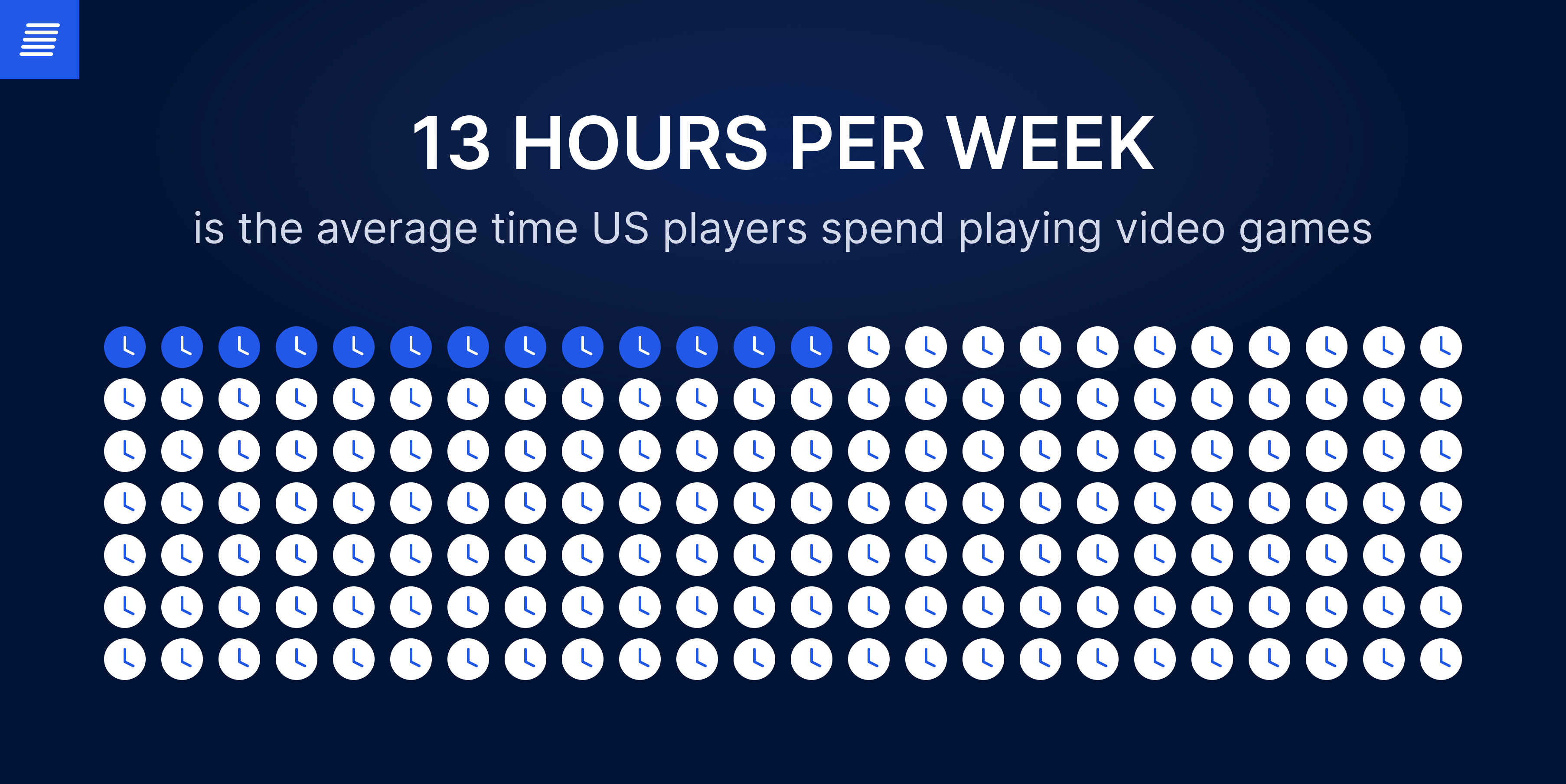
Gamification has long been a part of many industries, and technological advancements have made game elements even more accessible and entertaining. When gamifying their digital products, companies should consider several important benefits.
Statistics demonstrate that games play a significant role in our lives due to their ability to engage people’s interest and attention. Rewards, points, competitive spirit, and the pursuit of achievement—all these gaming elements contribute positively to customer satisfaction and retention.
Gamification offers users enjoyable and exciting experiences, which attracts new customers, expands the audience, and enhances brand visibility, thereby increasing brand recognition.
Building a community around a brand through user interaction with the game and each other can help enhance a company’s image and attract new customers.
Interactive content is a valuable tool for tracking customer behavior and engagement. Analyzing this big data can help companies tailor their strategies.
Gamification goes hand in hand with other trends aimed at enhancing user experience. Here are some of the main ones.
The integration of AI and gamification creates new opportunities for content personalization and data utilization. Gamification gives companies access to customer information (interactions, preferences, etc.) that can be used in combination with AI to design experiences that align with users’ interests.
AR and VR technologies are commonly associated with gaming, making them perfect tools for gamification. Using AR and VR, companies can create controlled environments for different activities, such as training, rehabilitation, or promotion of goods and services, to enhance user experience and engagement.
By integrating blockchain, companies can establish a transparent and secure gamified experience. This technology makes it possible to create smart contracts and track rewards (badges and points), which can be used as proof of achievement in challenges or training. Since only permissioned members have access to the gathered and stored information, blockchain is ideal for ensuring data security.
As user bases are anticipated to continue expanding indefinitely, handling extensive amounts of player and gaming data is becoming increasingly challenging for organizations. Data science effectively allows companies to harness these ever-growing data flows and extract actionable insights.
When discussing games, the first thing that comes to mind is entertainment. However, games offer numerous practical applications for businesses across various domains. Gamified systems are becoming increasingly popular, promoting innovation and user engagement. The global gamification market is expected to reach USD 48.72 billion by 2029, growing at a CAGR of 25.85% from 2024 to 2029.
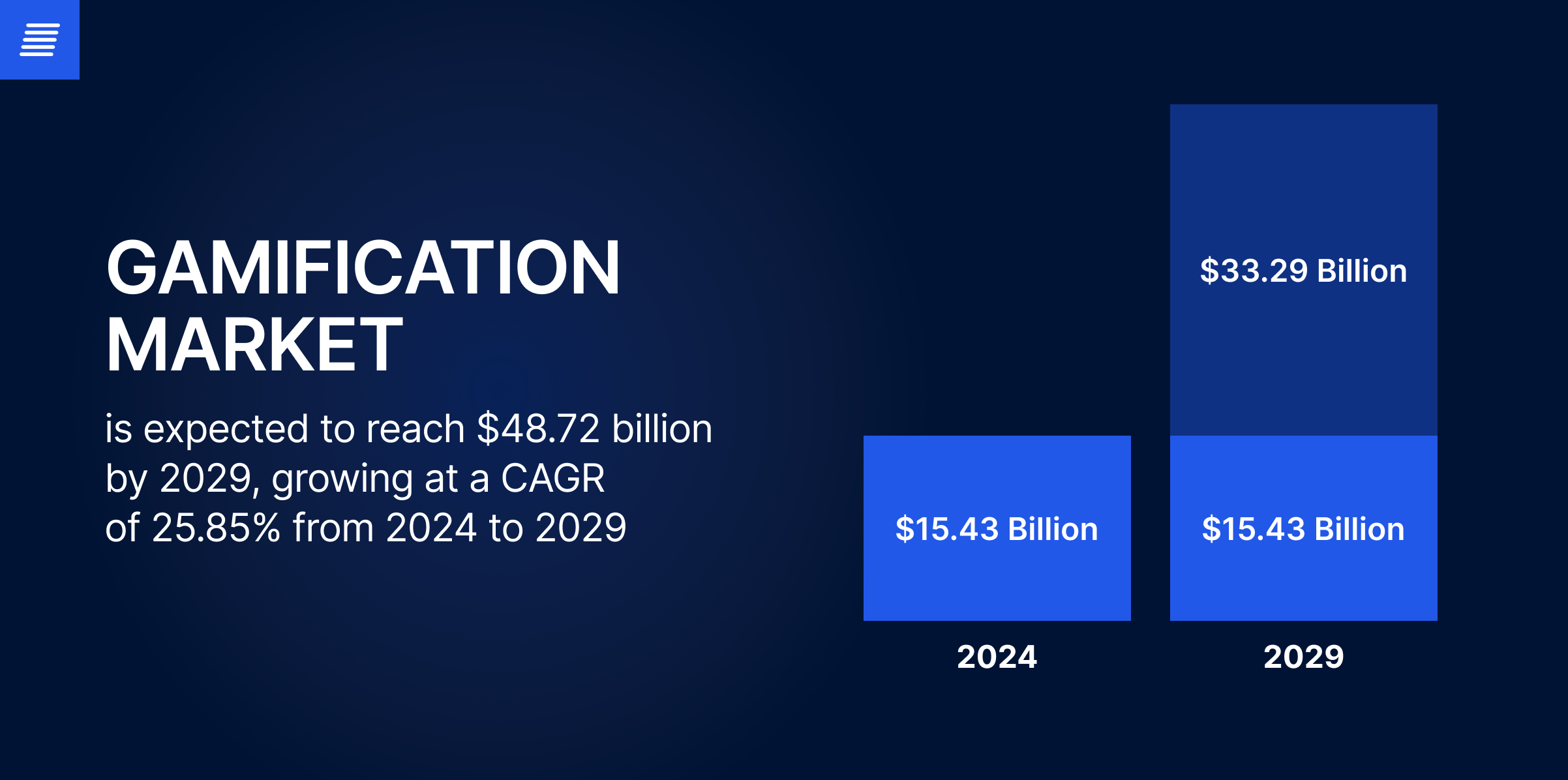
Most businesses have yet to unlock the full potential of gamification. However, various game elements offer numerous valuable use cases that can propel companies to new heights.
In marketing, gamification is a valuable tool with the power to captivate customers’ attention and prompt them to purchase a product or use a service. Marketers utilize several gamification mechanics in their campaigns, including:
Businesses often employ reward points, prizes, badges, or special offers for frequent customers to enhance their loyalty and engagement.
Setting goals for customers motivates them and fosters a sense of achievement. This approach is particularly effective for tracking progress in specific types of digital services or products, such as fitness apps.
Contests cultivate a competitive atmosphere, which is useful when companies want to motivate customers to participate and challenge others, thereby spreading awareness about the product or service.
The primary purpose of content is to deliver information, whether in video, text, or some other form. However, this information can be difficult to remember. Integrating gaming elements into the content encourages customers to interact with it, thereby improving memory retention.
The key aspect of gamified marketing is gathering customer data in the form of customer behavior through engagement and interaction. Marketers can utilize this information to adapt their strategies, catering to user preferences and engaging a wider audience.
Learning a new skill can be a time-consuming and tedious process, with little connection to the excitement of gaming. However, an increasing number of educators are incorporating gamified elements into learning. This approach not only makes learning more enjoyable but also serves as a means of inspiration and engagement.
Educators employ nearly identical gamification mechanics as marketers to enrich the process of acquiring knowledge. Rewards, badges, and point systems are universal strategies for motivating and encouraging students. Setting and achieving goals are important ways of tracking progress. Engaging learners through challenges, quizzes, and quests increases collaboration and enhances performance. Interactive content also enables students to more effectively memorize material and promotes creativity. 89% of Americans believe games can help build skills.
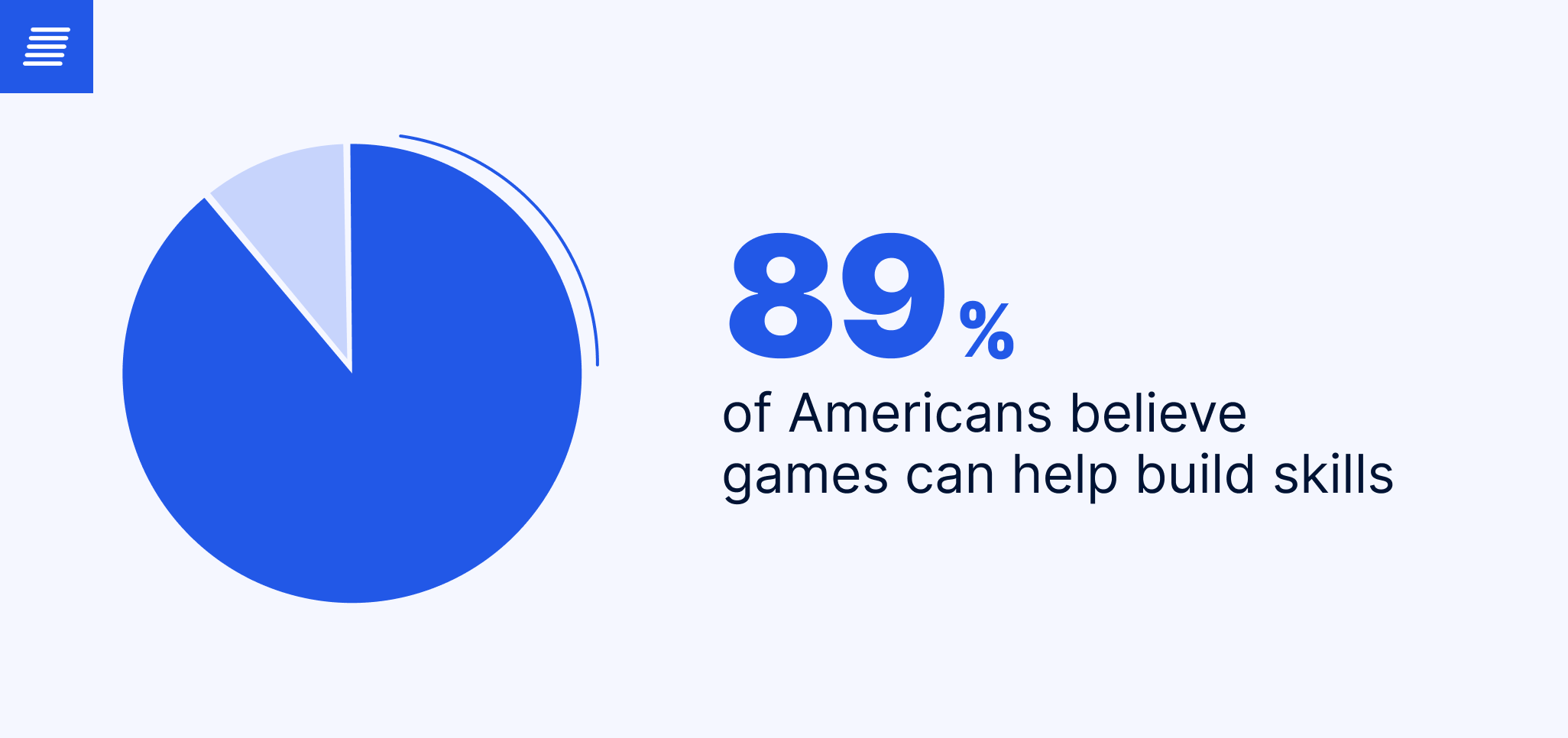
Games play a significant role in learning. For children, games can help develop cognitive, creative, collaboration, communication, and leadership skills while studying new material. For adults, gamified tutorials and courses offer an enjoyable way to comprehend and memorize information while engaging in a fun activity.
Integrating gamification into the healthcare sector presents numerous new opportunities and benefits for medical organizations, practitioners, patients, and health-conscious individuals. Gamified healthcare applications incentivize changes in patient behavior, improve the quality of medical services, and facilitate the collection of valuable patient data, such as treatment history, lifestyle choices, genetic information, health history, and current health status.
Following are some of the prominent uses of gamification in healthcare:
The success of a healthcare organization and the competence of medical personnel largely depend on timely and relevant training. Integrating game elements and technologies like VR and AR enables healthcare workers to practice, prepare for medical procedures and operations, and comprehensively study human organs and medical conditions.
In physical therapy and rehabilitation, the integration of gamification and VR helps with patient motivation, engagement, and concentration. Gaming elements can also reduce pain and anxiety by providing an immersive experience through fun exercises and relaxation techniques.
Remembering medication schedules and exercise routines can be challenging for patients. Gamification mechanics, such as rewards, points, and badges, help engage patients and establish positive, health-conscious behavior.
How do you make entertainment even more entertaining and engaging? Add gamification elements into non-gamified experiences. Increasingly, creators of TV shows, films, music, podcasts, and other entertainment and media forms are integrating gaming elements into their work, expanding their audience reach and increasing the popularity of their products. From film trivia to interactive event websites, polls during film screenings—the possibilities for gaming in entertainment are limited only by imagination. By incorporating gamification, entertainment experiences gain additional levels of involvement that create a sense of community and belonging among participants.
Another industry poised to capitalize on the benefits of gamification is retail. By integrating gaming, the retail industry can increase brand awareness, improve the shopping experience, enhance customer satisfaction, and boost sales.
Shopping is often a mundane task, but turning it into a game can make the experience pleasant. As with other industries, retailers employ various gamification techniques to engage buyers, including challenges, rewards, loyalty programs, and more. Using AR and VR, retail companies can provide customers with an immersive gamified experience by combining virtual objects with real-world surroundings, like letting them “try on” clothing virtually or see how furniture looks in a realistic environment.
The customer data gathered through gamified mechanics can help retailers personalize buyer experience, attract new buyers, reinforce customer loyalty, and increase revenue.
Around 40% of US retail decision-makers invested in gamified shopping experiences in 2023. Among them, 70% saw time on site increase.
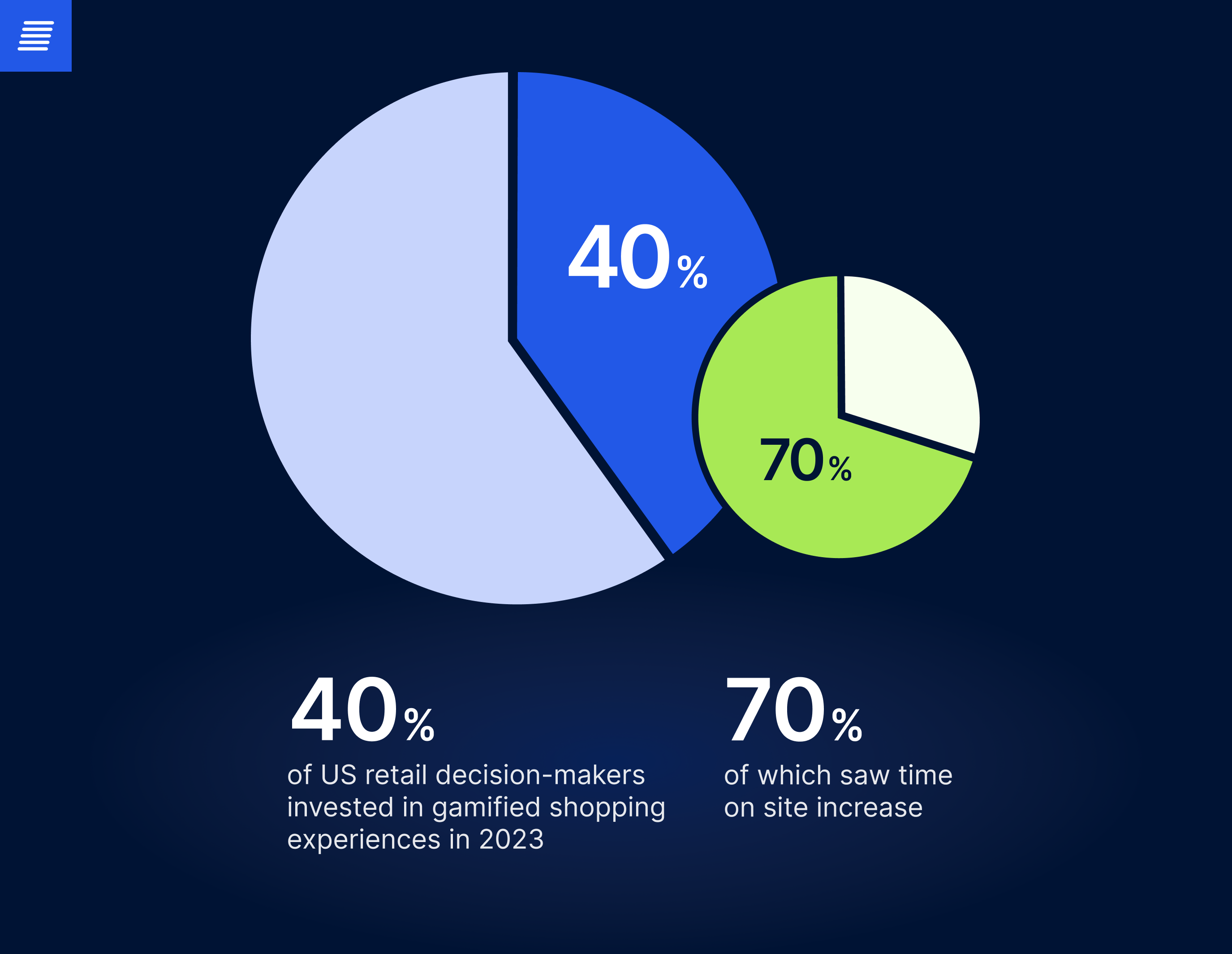
The fintech industry isn’t typically associated with entertainment, but there are still opportunities to incorporate games and gamified elements in this sector. There are several compelling reasons to integrate gamification into fintech products. Games can help companies promote financial literacy, engage and motivate customers, increase customer retention, and leverage the data gathered through game mechanics.
The same mechanics used in other industries are employed in fintech to encourage customers to set and achieve their financial goals, learn about financial processes and a company’s offerings, and establish healthy financial habits. This contributes to brand recognition and reliability, engages new customers, improves satisfaction and loyalty among existing customers, and motivates both potential and current customers to use a company’s services.
How can gamification be implemented in practice? One example is a platform that enables the creation of interactive gamified videos. The Adventr company, in collaboration with EffectiveSoft, developed a solution that helps creators produce engaging content that allows viewers to shape how the story unfolds by choosing from predefined options.
One element of the Adventr platform environment is the Interactive Cinema Backend, which makes the viewer experience even more entertaining. This tool is made for multiuser voting, allowing the film audience to define the plot through various scenarios. These scenarios include selecting from options against the clock, choosing by majority vote, randomly assigning a decision to an audience member, and more.
The Adventr solution brought to life the award-winning interactive short film, Lab Rat. The story follows a medical volunteer who joins a neurological experiment. The film’s audience decides how the experiment progresses by choosing from options on their smartphones. Lab Rat immerses viewers in moral dilemmas, challenging their ethical values. The film captures the audience’s attention by integrating community-based gaming. Lab Rat was screened at multiple conventions and received an award for Best Experimental Film at the DC Black Film Festival 2023.
The film’s success illustrates how gamification influences entertainment and other industries. Following this lead, other creators can develop memorable content that encourages the desired behavior.
Gamification is an excellent tool for engaging employees and customers and providing them with an extraordinary experience. Businesses now have new opportunities to engage and retain consumers using various game mechanics and harness the data collected through game interactions. To learn more about how gamification can revolutionize your business, contact our experts at EffectiveSoft.
Our team would love to hear from you.
Fill out the form to receive a consultation and explore how we can assist you and your business.
What happens next?